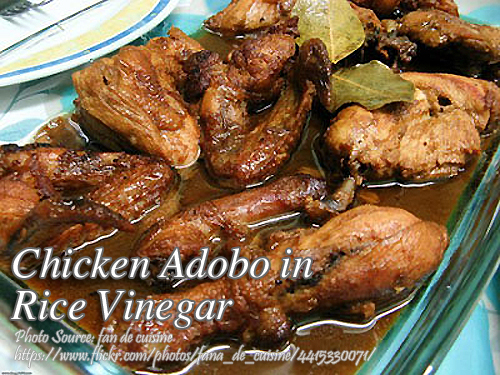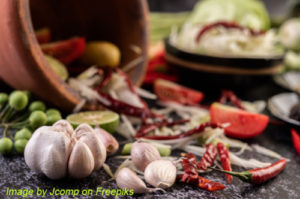What makes this chicken adobo recipe different from the original recipe? of course it is the rice vinegar. Rice vinegar is made from fermented rice or rice wine. It has a milder sweeter taste compared to regular vinegar and makers of this rice vinegar are from China, Japan, Korea and Vietnam. Rice wine is used mainly on asian cuisine and you might wonder if this adobo recipe I have here is truly a Filipino recipe. Soy sauce is also an adapted ingredient from the Chinese and Japanese so why not the rice vinegar?
Chicken Adobo with Rice Vinegar: A Twist on a Classic Dish
Adobo is one of those dishes found at the summit of the Filipino culinary mountain. It’s one of those dishes that will always forever be imprinted in the heart of every Filipino, each family having its own, and every single bite bursting with familiar flavors. My favorite experience with adobo is when I was still a little kid, watching Nanay Lita in the kitchen patiently simmering chicken and pork in that luscious, full-bodied marinade. But today, I would like to share with you a different twist on this popular dish, where it does incorporate rice vinegar.
I learned how to use rice vinegar in adobo from my Tita Nena who had moved to Manila after spending some years in Japan. She was very enamored of the ingredients used in Japanese cooking and still sends me recipes that I simply cannot cook with Filipino ingredients. On one visit, she brought out her version of chicken adobo for us. It was a pleasant surprise. The flavor was still very familiar but had a noticeable sweetness to it, and mild tanginess that set it apart. The secret? Rice vinegar.
The Subtle Charm of Rice Vinegar
So what is it, really, that makes rice vinegar so special? The difference is rather subtle in any case: Unlike the sharper bite of the traditional cane or palm vinegar found in many Filipino recipes, rice vinegar made from fermented rice has a sweet delight to it. It’s a staple in many Asian kitchens, especially in China, Japan, Korea, and Vietnam as used in sushi rice, dipping sauces, and countless other dishes.
Being a variant of adobo, I was not sure how the rice vinegar would play out with soy sauce, garlic, and peppercorns. According to Tita Nena, though, soy sauce is in itself an ingredient emulated from Chinese cuisine-so why not one more? The rice vinegar is subtle in its tang, making it a nice complement to the soy sauce, harmonizing flavors that may not be quite the same but still feels home.
A Taste from the Past, A New Discovery
Each time I make this variation of chicken adobo, it reminds me of our family reunions at my grandmother’s house in Cavite. There is always something special in the way she would cook her adobo. It would just get to simmer slowly for hours to let the meat absorb everything savory it has to offer. Though my lola would still be contented with the traditional cane vinegar, I feel she would appreciate the sublimely different flavor that this recipe accords. This one tastes more like the adobo we all grew up with but has this sweetness on it to temper a very strong vinegar taste.
I knew at once that the whiff of it alone was enough to bring memories to those who were served with it on a rainy Sunday afternoon. My brother, Kuya Jun, even mentioned that the smell of soy sauce, garlic, and bay leaves when they simmered in the pot instantly brought him back in his childhood years. But once he tasted it, he immediately sensed the difference – the sauce was a little less sharp, but not too heavy; still wonderfully tangy. That’s the beauty of rice vinegar: it lets other flavors shine without overpowering.
How to Cook the Perfect Chicken Adobo
Making chicken adobo using rice vinegar doesn’t much differ from the traditional method, but the key lies in balancing flavors. I start by marinating the meat – I like to use a combination of chicken and pork here, then soak it in soy sauce, garlic, bay leaves, peppercorns, and of course, rice vinegar. I like to let the meat marinate for at least half an hour to really let all those flavors soak into the meat, but if you have time, leaving it overnight is actually even better.
Then, you simmer the marinated meat slowly, topped up with water as needed to see that all these cook evenly. I learned something from Tito Boy, an expert in slow cooking-the key is patience when making adobo. “Good adobo takes time” and it is really true. Simmer that chicken and pork for about an hour until tender. Deep flavor abounds in each bite.
This little trick I got from Ate Mila, my cousin who’s a chef in Quezon City. Do this: After cooking, take the meat out of the pot, fry it a bit in a little oil until golden brown, then put it back into the sauce. Gives some really nice contrasting texture – crispy outside, tender inside. But if you like your adobo straight from the pot, that works just fine too.
A Dish Steeped in History
Adobo has always been a dish with a rich history. Long before the Spaniards gave it its name, the indigenous Filipinos were already cooking meat in vinegar and salt as a means of preservation. Through the years, of course, it evolved, each region and household putting their own touches on it-whether it’s the addition of coconut milk in some parts of the Visayas or the use of siling labuyo for a bit of heat.
Adding rice vinegar into this recipe adds just another page to the long history of adobo, and it really exemplifies how the Filipino cuisine evolves, borrowing bits from other cuisines but adding flavor in the context of ours. This version may hold Asian cuisine roots, but it is not a far cry from carrying the heart and soul of a traditional Filipino dish.
A Delicious Twist Worth Trying
This is one such version of the dish chicken adobo with rice vinegar that I want to try out, which still comes to you with comfortable flavors of a favorite classic. This version really is so close to my heart because it’s one of those recipes passed from generation to generation, each one putting their little twist on it. Whether you’re a lover of adobo, just like me, or it’s just your first time trying one, I hope that this recipe shall fill you with the same amount of joy and nostalgia for as it has done for me and my family.
How to Cook Chicken Adobo in Rice Vinegar
Ingredients
- 1 whole medium sized dressed chicken cut into serving pieces
- 1 cup rice vinegar
- 2 Tbsp. crushed garlic
- 1 tsp. whole black pepper
- 3 pcs bay leaves
- 1 Tbsp. salt
- 4 Tbsp. soy sauce
- 1/4 kilo pork cut into serving pieces
- 1 1/2 cup water
Instructions
How to cook chicken adobo in rice vinegar:
- Combine all ingredients except water. Marinate for at least 1/2 hour.
- Place pork, water, and marinade in saucepan and cook 30 minutes (simmering).
- Add the chicken. Simmer for additional 45 minutes to 1 hour.
- You can serve as is or remove the meat from the pot and fry until brown in small amount of oil and return to the sauce.
Notes
Cooking Tips:
Marinate for Deeper Flavor
When you really let the chicken marinate in soy sauce, rice vinegar, and spices for at least 30 minutes or overnight, this could be where it really brings out that depth in the adobo. By soaking the meat in the marinade for some time, all those rich and tangy notes stand a great chance of being really absorbed by the meat. And the longer it stays in there, the more flavor-filled your adobo is going to be.Long Simmer for Falling-Apart Meat
When cooked low and slow, the meat is tender and juicy. Low simmering helps to blend the flavors and not dry or toughen the meat. Patience in order for the entire depth of the sauce is absorbed.Fry: Tex-Mex Variation
After simmering, briefly fry the chicken in little oil to give it a golden outer layer, crispy and so delightful to contrast with the tender, savory meat. Then fry it, put it back into the sauce, and then immediately serve.





